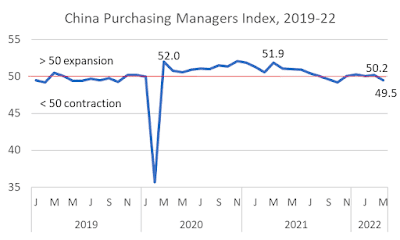Virus, War Tip China Businesses into Contractionary Phase

Much of China's economy tipped into a contractionary phase this month due to virus outbreaks and geopolitical instability, according to the country's National Bureau of Statistics. The Bureau's purchasing managers index (PMI) declined to 49.5 in March 2022, down from 50.2 the previous month. The nonmanufacturing business index fell to 48.4 (down 3.2 points)--indicating shrinking services industry activity. An index below 50 indicates business is contracting, while above 50 indicates expansion. The March PMI indicates renewed contractionary pressure similar to numbers posted last September-October. The month's sub-50 index is a reversal of weak expansionary numbers posted from November to February. March has often been a strong month for the Chinese economy. The index hit 51.9 a year ago in March 2021. The index was 52.0 in March 2020 as the economy emerged from a February 2020 deep-freeze lock-down. Compiled from National Bureau of Statistics reports. One of the Burea...

